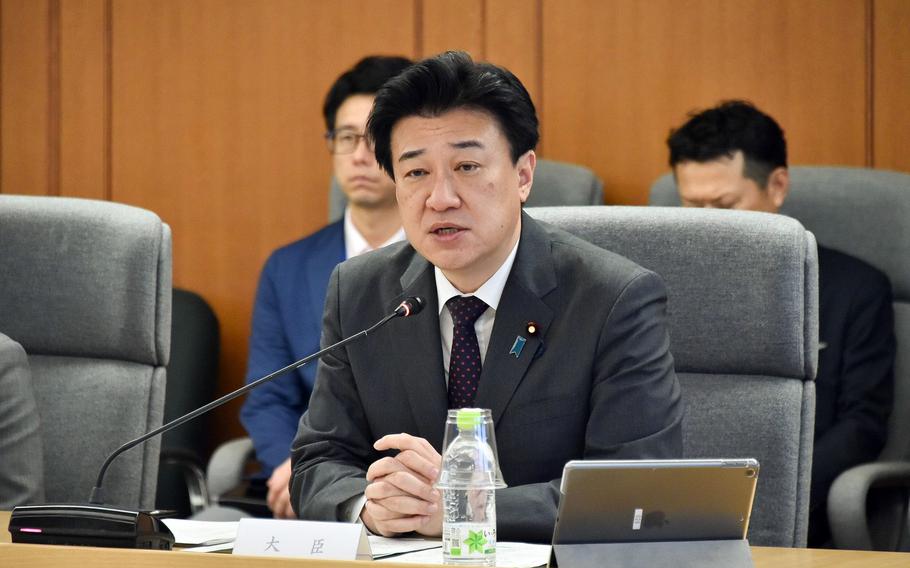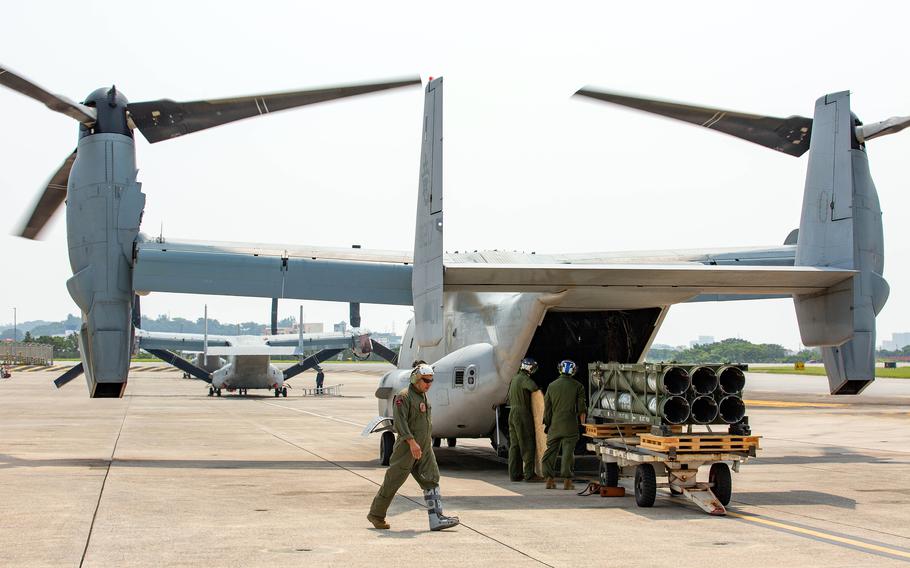Asia-Pacific
Japan’s defense minister rejects incremental relocation of Marine airfield on Okinawa
Stars and Stripes September 11, 2024

Japanese Defense Minister Minoru Kihara speaks during a meeting about his country's defense capabilities, Aug. 30, 2024. (Japan's Ministry of Defense)
CAMP FOSTER, Okinawa — Relocating a Marine Corps airfield from a heavily populated city on Okinawa to a rural northern area in phases would unnecessarily lengthen the time to build the new facility, Japan’s defense minister said this week.
Defense Minister Minoru Kihara during a press conference Tuesday pushed back on a campaign pledge by Ginowan city’s new mayor, Atsushi Sakima, to “realize a phased relocation” of Marine Corps Air Station Futenma to a new airfield under construction on Camp Schwab in the Henoko region.
“If we relocate part of the aircraft stationed at Futenma, which I assume is what phased relocation means … it will be necessary to build temporary facilities like hangars and fuel tanks on the Henoko side,” Kihara said. “If we build those temporary facilities, it means that eventually they need to be demolished.”
Sakima also pledged to “push (the government) to show a date for the reversion of MCAS Futenma,” according to a Friday post on social platform X. Sakima, backed by Japan’s Liberal Democratic Party, was elected Sunday to succeed Masanori Matsugawa, who died July 26 at 70.
The new airfield is being built on reclaimed land in Oura Bay. The U.S. and Japanese governments agreed to move the base in 1996, but construction of the new site was repeatedly delayed by the Okinawa prefectural government.
Chief Cabinet Secretary Yoshimasa Hayashi in January announced the resumption after four idle years of work to reclaim land from the bay. Workers began driving piles into the soft seabed to begin reclamation process Aug. 20, a spokesman for the prefecture’s Seashore Disaster Prevention Division said that week. The ministry drove test piles into the bay in July.
Construction will take just over eight years to complete, and another two years and nine months to finish paperwork and other procedural measures before turning the airfield over to the Marines, Kihara said.
“It is necessary to consider the process to relocate troops after finishing constructions,” he said, declining to give a specific reversion date.
“At this point, it is difficult to indicate concretely, but we will continue working closely with the U.S. to be able to realize a quick reversion of MCAS Futenma” after the new airfield is complete, he said.

Marines load M142 High Mobility Artillery Rocket System launcher pods onto an MV-22B Osprey at Marine Corps Air Station Futenma, Okinawa, May 8, 2024. (Daniel Avilaramirezk/U.S. Marine Corps)
MCAS Futenma is home to Marine Aircraft Group 36 and Marine Air Control Group 18 of the 1st Marine Aircraft Wing, as well as the base’s Headquarters and Headquarters Squadron. Aircraft stationed there include CH-53 Super/Sea Stallion heavy lift helicopters, CH-46 Sea Knight helicopters and MV-22 Osprey.
The construction zone at Schwab is divided into two main sections: 279 acres on the base’s north side and 91 acres in the south, according to the prefecture’s website. Work on the Oura Bay, or north, side, was on hold from April 21, 2020, when Okinawa Gov. Denny Tamaki, citing safety and environmental concerns, refused to approve design changes meant to solidify the seabed.
Tamaki filed, and lost, three lawsuits, culminating in a September 2023 loss at the Supreme Court of Japan. Japanese Minister of Land, Infrastructure, Transport and Tourism Tetsuo Saito approved the construction permits Dec. 28 after Tamaki ignored a Dec. 25 deadline from Fukuoka High Court.